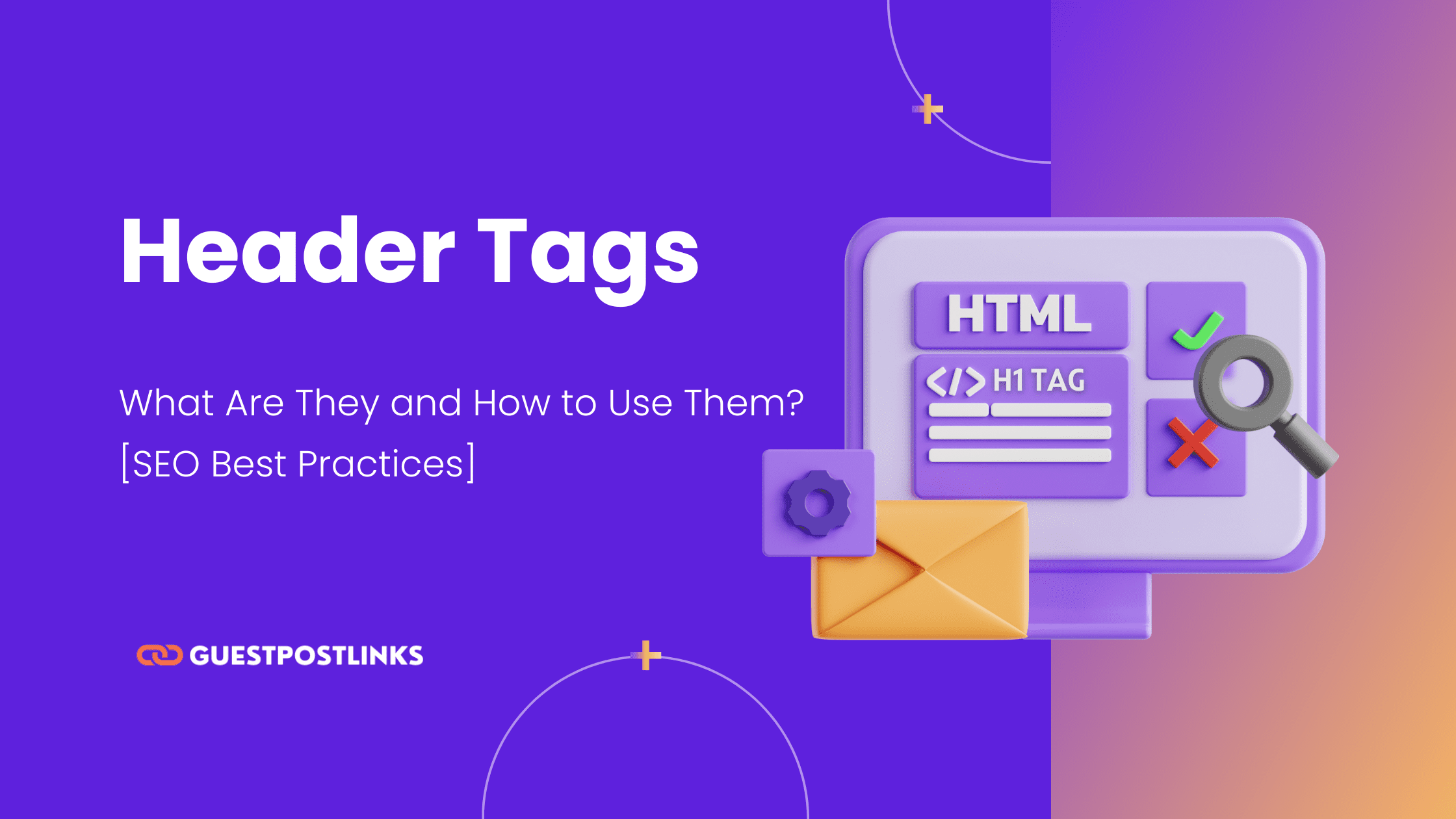Header Tags: What Are They and How to Use [SEO Best Practices]

In this digital age, effective Search Engine Optimization (SEO) strategies are crucial for driving organic traffic to your website. One essential aspect of on-page SEO is the proper utilization of header tags.
In this comprehensive guide, we’ll delve into the world of header tags, exploring what they are, how they impact SEO, and the best practices to optimize them for enhanced online visibility.
What Are Header Tags?
Header tags are HTML elements that are used to organize your content hierarchy and provide a better user experience. These HTML elements range from H1 to H6, with H1 representing the highest level of importance and H6 the lowest. They serve two main purposes: they provide a clear outline of the content’s structure to readers, and they signal to search engines which parts of your content are more important and relevant. Think of header tags as the signposts that guide both your audience and search engine crawlers through your content.
Also Read: Ultimate SEO Glossary: 499+ Essential SEO Terms You Need to Know!
Best Practices for Using Header Tags:
1. H1 Tag
The H1 tag serves as the main title of your content and should be unique on each page. It sets the overall theme and topic of your page. Use your primary keyword naturally in the H1 tag.
2. H2 Tags
H2 tags represent section headings and break down your content into meaningful subtopics. Use variations of your primary keyword to maintain relevance.
3. H3-H6 Tags
These tags provide further subdivision within sections, helping to organize content. While not as impactful as H1 and H2 tags for SEO, they enhance readability and structure.
4. Keyword Consistency
Maintain a consistent keyword theme across your header tags and content. However, avoid keyword stuffing, which can negatively impact your SEO efforts.
5. Concise and Descriptive
Craft clear and concise header tags that accurately reflect the content of each section. This approach enhances both user experience and search engine understanding.
6. Hierarchy Matters
Follow a logical hierarchy when using header tags. Use H1 for the main title, H2 for subheadings, and subsequent tags for further subdivisions.
Why Are Header Tags Important for SEO?
The Role of Header Tags in SEO:
Header tags have a significant impact on your website’s SEO. When search engines crawl your page, they pay close attention to these tags to understand the context and relevance of your content. Here’s how header tags contribute to your SEO efforts:
1. Keyword Emphasis
Header tags allow you to emphasize target keywords, which gives search engines a clear idea of what your content is about. Including relevant keywords in your header tags can positively affect your rankings for those keywords.
2. Content Structure
Well-structured content enhances user experience. Header tags create a hierarchy that breaks down your content into sections, making it easier for readers to navigate and understand. It is crucial to structure your content for SEO, ensuring that search engines can easily comprehend and rank your pages effectively.
3. Featured Snippets
Using header tags strategically can help you secure a featured snippet on Google’s search results page. This coveted position displays a concise answer to a user’s query, providing you with high visibility and authority.
Tips for Optimizing Header Tags:
1. Mobile-Friendly Formatting
Ensure your header tags are responsive and display well on all devices, as mobile-friendliness is a crucial SEO factor.
2. Use of LSI Keywords
Incorporate Latent Semantic Indexing (LSI) keywords in your header tags and content. These related terms provide context and depth to your content.
3. External Links
Include high-quality external links in your content to provide additional value to readers and signal credibility to search engines.
4. Visual Appeal
Optimize header tags for visual appeal by using appropriate fonts, colors, and formatting that align with your website’s design.
How to Add Header Tags in HTML
1. Open an HTML Document
Begin by creating a new HTML document or opening an existing one in a text editor or an integrated development environment (IDE).
2. Choose the Appropriate Header Tag
Select the appropriate header tag based on the level of importance for the content. The higher the number, the lower the importance. For instance, H1 is the highest level and usually represents the main title, while H2, H3, and so on represent subheadings.
3. Insert the Header Tag
Use the following syntax to insert header tags:
<h1>This is an H1 Header Tag</h1>
<h2>This is an H2 Header Tag</h2>
<!-- Similarly, you can use H3, H4, H5, and H6 tags -->
4. Add Your Content
Insert your content within the header tags. This content can include text, images, links, or any other HTML elements.
5. Repeat for Subsections
If you have subsections within your content, use appropriate header tags to maintain a hierarchical structure:
<h2>Introduction</h2>
<p>Content for the introduction goes here...</p>
<h3>Benefits of Header Tags</h3>
<p>Details about the benefits...</p>
6. Styling with CSS
You can apply CSS styling to your header tags to control their appearance. For example:
<style>
h1 {
color: #333;
font-size: 28px;
}
h2 {
color: #666;
font-size: 24px;
}
</style>
7. SEO Best Practices
To optimize your header tags for SEO, ensure that your primary keyword appears naturally within the H1 tag. Use variations and related terms in subsequent header tags (H2, H3, etc.).
8. Preview and Test
Preview your HTML document in a web browser to see how your header tags look and if they are correctly nested. Additionally, use browser developer tools to inspect your header tags’ styling and structure.
9. Responsive Design
Remember to make your header tags responsive to ensure a consistent appearance across different devices, such as smartphones and tablets.
10. Validate Your HTML
After adding header tags, use online HTML validators to check for any syntax errors or issues in your code.
Conclusion
Incorporating header tags into your website’s content strategy is a powerful way to enhance both user experience and SEO performance. By following the best practices and tips outlined in this article, you can effectively utilize header tags to improve your content’s visibility on search engines, provide valuable information to your audience, and create a seamless browsing experience.
Remember, header tags are not just HTML elements; they’re the roadmap to better SEO and an engaging user journey.
FAQs
Which of the following tags defines a table header?
Table headers are defined using the <th> tags in HTML. These tags indicate that the content within them is a header cell in a table, providing context to assistive technologies and making the table more accessible.
Are header tags essential for SEO?
Header tags are indeed essential for SEO. They improve content structure, keyword emphasis, and overall user experience, all of which contribute to better search engine rankings.
Do header tags impact voice search SEO?
Yes, header tags indirectly impact voice search SEO. Well-structured content with clear header tags is more likely to be featured in voice search results.
How many H1 tags can a page have?
While there can technically be multiple H1 tags on a page, it’s best practice to have only one H1 tag as the main title. Subsequent headings should use H2, H3, and so on.
Why should I not place too much text in header tags?
While header tags are great for organizing content, placing excessive text within them can harm user experience and SEO. Header tags are meant to provide a concise summary of the content that follows, making it easier for readers and search engines to understand the page’s structure and topic.




